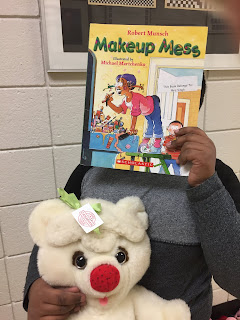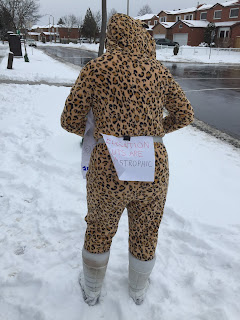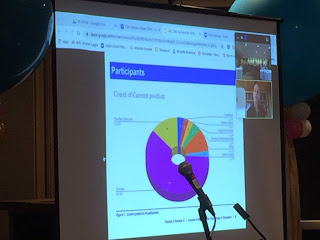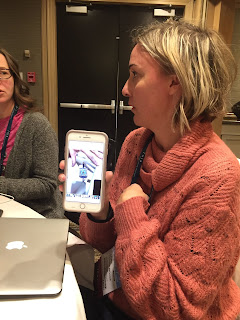Diana’s posts are always complex, and usually involve a few different topics connected together in the most wonderful of waysThat's very perceptive. I actually make an effort to combine several thoughts swirling in my head together because I only write once a week. Thinking and writing about events helps me sort things out, and for the reader, it means that if someone isn't drawn in by one of the topics, they might be by one of the others.
My original intention (based on the last sentence of last week's blog) was to talk about my new student-teacher. As is my usual practice, I told her my plans and asked if it would be okay if I wrote about her and shared some photos of her on my blog. She gave some parameters, which I have respected in this post.
That gave me a new tangent to explore - what Jennifer Casa-Todd calls creating "a culture of consent". (Read her blog about the topic at https://jcasatodd.com/normalizing-a-culture-of-consent-on-social-media/).
 |
| Thank you Farah Wadia for taking this photo of me |
I was surprised that she was surprised - and disappointed too. It must be very common that the act of obtaining consent is completely ignored. I've written about consent before (in 2018) and my views on the issue still remain consistent. Ask. If people ask for boundaries or limits, listen to them. When it comes to children, ask them too, but err on the side of caution - they may not be aware of how long-lasting an image, video, or comment linked to their name might remain. (That's why the photos I took of students reading for I Read Canadian Day have no faces. Sonia Singh, who also took photos of her students, also respected the balance between her students' privacy and their desire to be captured on film and celebrated.)
And if you forget and post without permission, own up to the error, check in with the person, and make changes if necessary. For instance, I posed a tweet and a photo about a wonderful colleague of mine, Farah Wadia, and the interview she gave during our strike on Friday. I didn't check with her first; thankfully when I contacted her, she gave me her consent to keep the tweet up. (Sorry for the slip-up, Farah!)
I'm so stinking proud to call @mswadia my colleague and friend. She was interviewed by a news outlet today and was poised, professional, got her point across and did not resort to any mudslinging in her comments. Great job! #ETTStrong #ETFOStrong @ETFOeducators @ElemTeachersTO pic.twitter.com/ICiTZWptPF— Diana Maliszewski (@MzMollyTL) February 22, 2020
This leads me back to my student-teacher. She mentioned that in her Faculty of Education training, they were cautioned repeatedly about using social media. (The teacher-candidates are quite aware of the Ontario College of Teachers guidelines around the use of electronic communication and social media - I just wish the take-away for many of them wasn't/isn't to avoid it completely.)
I know how important it is to have a good associate teacher / host teacher. I was in the Concurrent Education program at the Faculty of Education at York University. I had three year-long placements with three different locations during my teacher formation time. Most of those experiences were extremely positive, but I contemplated quitting the Faculty of Education because of one of those placements. While in that particular teacher's room, I felt like I couldn't do anything right. I was belittled and treated like a second-class citizen. I wasn't allowed to sit in the "teacher's chair" until my month-long teaching block in May. Some of the habits I developed as coping mechanisms and/or part of that teacher's advice took years to undo. I told myself that if I was ever fortunate to be a host teacher, I would be different.
SC is a Year 2 Faculty of Education student at the Ontario Institute for Studies in Education at the University of Toronto. When she graduates, she will have her Junior-Intermediate qualifications and she plans on gaining her Primary qualifications shortly afterward. I have learned so much from SC already, and it's only been a week! She was the one who introduced me to a term I had never heard before (TPR - Total Physical Response). SC explained to me that ELL teachers use this technique to increase understanding for their students and she noticed that some of the ways I talk to my students include TPR techniques. I'm going to have to investigate this further. I had no idea.
 |
| SC helping a student with tech for a project |
There are many things I really appreciate about SC. She likes and responds to feedback and is keen to try new things. Simultaneously, she is aware of and able to establish her comfort level and isn't afraid to say "no" or "not yet". Boundaries are good and healthy!
 |
| SC reading a book to a kindergarten class |
SC is a hard worker who has stepped up quickly to the demands of teaching in a school library space, reading several books from the Forest of Reading list for 2020 so she can be prepared to chat with junior and intermediate division students like I do.
SC is prepared and her first whole-class lesson (a STEAM session with Grade 2s) went well. I can hardly wait to see the cardboard cabinets that the students make with her.
There's a lot of information to take in, especially because most of SC's prior placements have been in Grade 6-8 and she is now interacting with K-8. I've noticed that she is working on building rapport with as many students as she can, which is no easy feat. The current work-to-rule situation makes it doubly challenging, because we can't talk leisurely after school or plan / set-up early in the morning.
As a new host teacher, I have other concerns too, none of which centre on SC. I worry that this unusual circumstance (i.e. SC's first teaching week was only three days, because of Family Day on Monday and the province-wide strike on Friday) will deprive SC of some of the full experience of being at my school. I also worry that SC will feel the need to model her teaching on mine - my teaching is a reflection of my training and identities and although I stand by the methods and techniques I use, I hope SC doesn't employ them just because I do. Then there's my modified teaching priorities - I'm doing a lot less information literacy and research skills with the upper grade students than I've done in the past, because we need to use the time during the instructional day to address the literacy goals related to the Forest of Reading. This may give SC a skewed image of the school library as "just about books and reading". I'll need to let go of my worries and go with the flow. I hope SC enjoys her placement as much as I already have.






















































